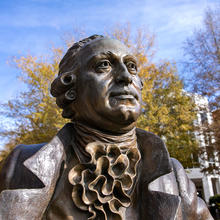- November 11, 2021
The National Science Foundation (NSF)’s I-Corps program is an accelerator that helps entrepreneurs and researchers work together “to bring invention to impact.” Mason serves as an official I-Corps site, supporting local grantees through the exploratory stages of venture-building, as well as preparing them to apply for the national-level program.
George Mason University is poised to be named a managing member in the Cybersecurity Manufacturing Innovation Institute (CyManII), a $111 million public-private partnership led by the University of Texas at San Antonio.
Environmental researcher Lucas Henneman is investigating air pollution’s impact on health. He uses large datasets and computer models to track pollution after it’s emitted from sources such as automobiles, coal power plants, and natural gas plants. The models help identify which people in nearby communities breathe in pollution.
Since the start of the coronavirus pandemic, the National Science Foundation has awarded more than 800 Rapid Response Research (RAPID) grants designed to get researchers into the field and lab quicker than the traditional grant process.
George Mason University is taking the lead in a grant from the National Oceanic and Atmospheric Administration (NOAA) designed to assess the threat of rising sea levels and flooding to Maryland’s coastal communities.
New trade routes in the Arctic mean unprecedented traffic and industrialization are likely to follow, so George Mason University’s Elise Miller-Hooks and her team of scientists will be taking a closer look at what that will mean for the region’s infrastructure and governance thanks to a $3 million National Science Foundation grant for a project called “An Expanding Global Maritime Network, Its Arctic Impacts and Reverberations.”








